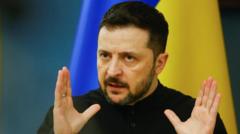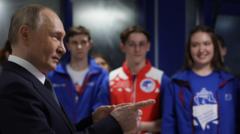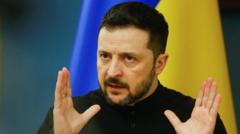Leaders from Russia and Ukraine have reached a preliminary ceasefire agreement, signed in Saudi Arabia, aimed at curbing violence in the Black Sea. However, the Kremlin's stringent conditions complicate matters, leaving many uncertainties about the future of this fragile peace.
Fragile Ceasefire Agreement Emerges from Ukraine Talks, Yet Doubts Loom

Fragile Ceasefire Agreement Emerges from Ukraine Talks, Yet Doubts Loom
After extended negotiations in Saudi Arabia, Russia and Ukraine have outlined a tentative ceasefire agreement, but conditions imposed by the Kremlin may hinder its effectiveness.
After three days of intense discussions in Saudi Arabia, progress has been made towards a tentative ceasefire agreement between Russia and Ukraine. Two distinct accords have emerged; one sees cooperation between the US and Russia while the other involves the US and Ukraine. Despite some discrepancies, the key elements largely align. Notably, all parties have agreed "to ensure safe navigation, eliminate the use of force, and prevent the use of commercial vessels for military purposes in the Black Sea." Furthermore, they have committed "to develop measures for implementing... the agreement to ban strikes against energy facilities of Russia and Ukraine."
President Zelensky expressed regret over the absence of an explicit ban on civilian infrastructure attacks but appeared optimistic about the agreements. He informed reporters that Ukraine would take immediate steps to observe the Black Sea and energy ceasefires. Additionally, the US reaffirmed its commitment to assisting in the exchange of prisoners, releasing civilian detainees, and facilitating the return of Ukrainian children who had been forcibly moved.
However, complications arose with the release of a third document from the Kremlin, which introduced new stipulations that were not included in the initial US-Russia agreements. The Kremlin stated that the Black Sea ceasefire would only be effective after the removal of sanctions on Russian entities, including banks and companies, which would subsequently enable the export of agricultural goods. This condition suggests that Russia views the agreement not merely as a reinstatement of the Black Sea Grain Initiative, a deal abandoned in 2023, but also as a chance to undermine existing economic sanctions.
The timeline for implementing these recommendations remains uncertain, particularly since the US may lack the capacity to fulfill all of Russia's demands independently, especially regarding the return to the SWIFT financial system, which would require EU involvement.
The Kremlin further mentioned that the 30-day halt on energy strikes would retroactively commence from March 18 but could be rescinded if either party violates the terms. Thus, while a delicate step towards reducing hostilities in Ukraine has been taken, the road to a comprehensive nationwide ceasefire remains fraught with difficulties and skepticism.
It has been widely acknowledged that ceasefires are often viewed as processes rather than singular events. This perspective rings particularly true now; the true measure of success will lie not in the announcement but in the arms' enforcement and adherence to the terms agreed upon. The critical question now is whether both nations will commit to making this agreement transformational and whether their intentions lean towards fostering lasting peace or merely tactical advantages.



















